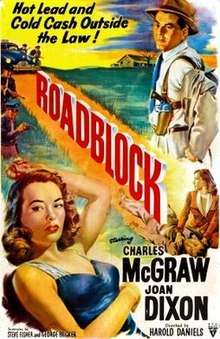Roadblock (film)
Roadblock is a 1951 American film noir starring Charles McGraw and Joan Dixon. The 73-minute crime thriller was shot on location in Los Angeles, California. The film was directed by Harold Daniels and the cinematography is by Nicholas Musuraca.
| Roadblock | |
|---|---|
 Theatrical release poster | |
| Directed by | Harold Daniels |
| Produced by | Lewis J. Rachmil |
| Screenplay by | George Bricker Steve Fisher |
| Story by | Richard H. Landau Daniel Mainwaring |
| Starring | Charles McGraw Joan Dixon |
| Music by | Paul Sawtell |
| Cinematography | Nicholas Musuraca |
| Edited by | Robert Golden |
| Distributed by | RKO Radio Pictures |
Release date |
|
Running time | 73 minutes |
| Country | United States |
| Language | English |
Plot
Insurance investigator Joe Peters (McGraw) and his partner Harry Miller (Louis Jean Heydt) solve a case and prepare to fly home. Joe meets Diane (Dixon) at an airport. She pretends to be his wife without his knowledge in order to get a large discount on the airfare. They wind up sharing a hotel room after a storm forces an unscheduled stop.
Joe is attracted to Diane, despite his dislike for "chiselers". She makes it quite clear she loves the finer things in life, which "Honest Joe" (as Diane calls him) cannot possibly afford on his small salary of $350 a month, so they part when they reach Los Angeles.
By coincidence, when Joe and Harry are assigned to check out Kendall Webb (Lowell Gilmore), the prime suspect in a fur robbery, Joe runs into Diane, who is now Webb's girlfriend. Their mutual attraction flares up and Joe, in order to finance a dream life with Diane, decides to use his own inside knowledge of a $1,250.000 cash shipment to set up a robbery for Webb. Joe wants one-third of the money.
Ironically, Diane decides that her love for Joe is greater than her love of money. When she tells Joe she wants to get married, he tries to back out of his deal with Webb. However, Webb convinces him that Diane might not feel the same after a few months living on his paltry pay. The robbery coincides with Joe and Diane's honeymoon, giving him an alibi. Eventually, Joe confesses to Diane what he has done.
The railway mail car robbery is successful, but a railroad employee is injured and later dies. Things go downhill from there. One of the robbers is identified and arrested. Desperate, Joe arranges to meet Webb on a desolate stretch of highway by telling him he has a plan to get them out of their mess. However, after a struggle, he knocks Webb out and stages a car accident in which Webb is killed and his share of the money partially burned.
Harry figures out that his partner is involved and pleads with him to turn himself in. Instead, Joe tries to flee to Mexico with Diane, but is tracked down and shot. He dies in Diane's arms.
Cast
- Charles McGraw as Joe Peters
- Joan Dixon as Diane
- Lowell Gilmore as Kendall Webb
- Louis Jean Heydt as Harry Miller
- Milburn Stone as Egan
Reception
Critical response
Hans J. Wollstein, writing for Allmovie, calls the film a "low-budget but highly engrossing film noir".[2] The film is indeed so low-budget that stock footage has been inserted into the scene where the car accident is set up, meaning that two distinctly different automobiles cause Webb's brutal and fiery death. Presumably the car actually being used in the film was required to be returned intact to the studio stores afterwards.
Dennis Schwartz, at Ozus' World Movie Reviews writes, "In the end everything was done in such a flat manner, that it was hard to care that straight-shooter McGraw lost his integrity and life for an icy broad who ironically would have loved him the way he was."[3]
Noir analysis
In noir fashion, sex and money lead to Peters' destruction in the film. According to film critics Bob Porfiero and Alain Silver, the screenwriters took a hard-boiled mystery plot and combined it with "an aura of middle-class malaise and pervasive corruption to provide a motivation for Peters' alienation and fall." The noir notion of entrapment is illustrated by the staging of Peters' death in the semi-dry Los Angeles river bed, in one of the first car chases to be filmed there.[4]
References
- "Roadblock: Detail View". American Film Institute. Retrieved May 19, 2014.
- Wollstein, Hans J. Allmovie, film review. Last accessed: December 8, 2007.
- Schwartz, Dennis. Ozus' World Movie Reviews, film review.
- Silver, Alain and Elizabeth Ward. Film Noir: An Encyclopedic Reference to the American Style. Film noir analysis by Bob Porfiero and Alain Silver, page 244. The Overlook Press, 3rd edition, 1992. ISBN 0-87951-479-5.
External links
- Roadblock on IMDb
- Roadblock at AllMovie
- Roadblock at the TCM Movie Database
- Roadblock film scene on YouTube